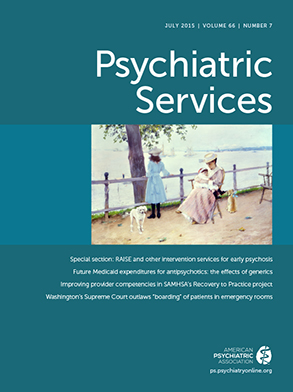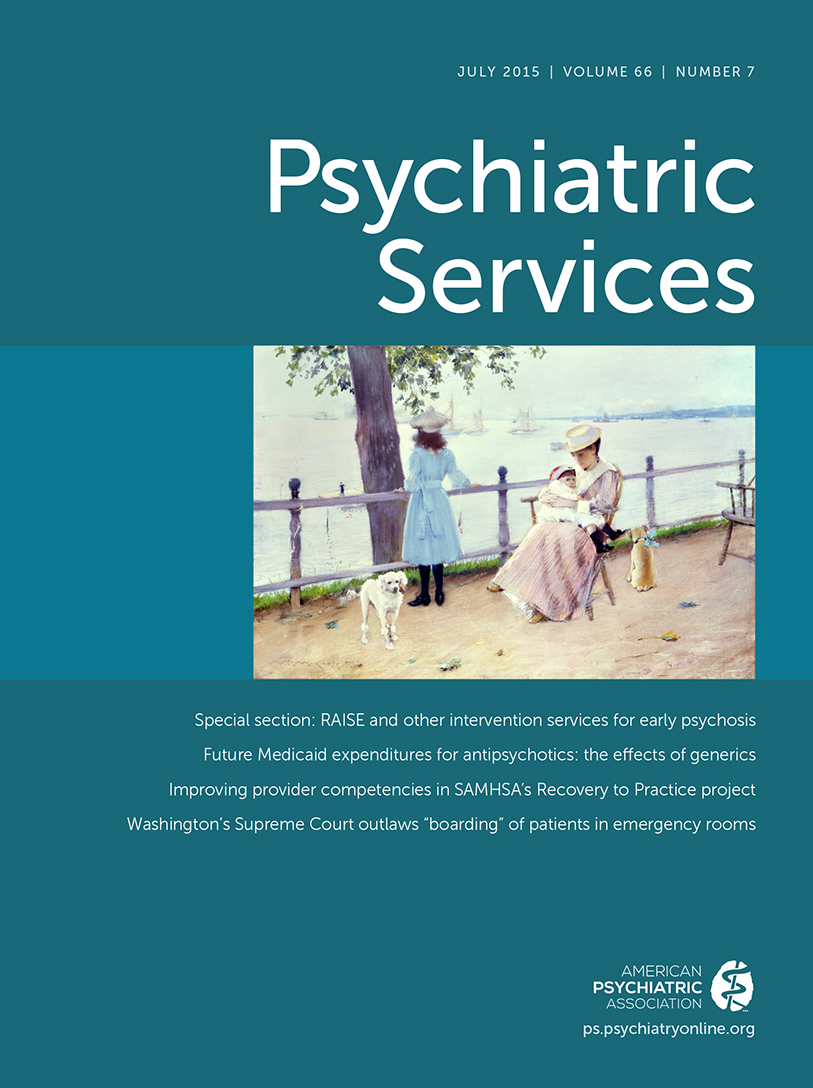Recent studies examining interventions early in the emergence of psychosis have yielded promising results (
1,
2). The RAISE study (Recovery After an Initial Schizophrenia Episode), which is supported by the National Institute of Mental Health (NIMH), is an attempt to scale an early intervention for psychosis within publicly supported mental health delivery systems. RAISE emphasizes early identification of people experiencing a first episode of psychosis and engagement of the affected individuals in a package of evidence-based treatments and supports that seek to attenuate the disabling effects of psychosis.
To date, the NIMH initiative has been funded by special grants (New York and Maryland) or through ad hoc cross-subsidies engineered by participating clinical programs (
3). Wide application of the promising intervention (or ones modeled on it) requires a funding mechanism that is both compatible with approaches already used by payers and generates incentives for providers that promote the desired behaviors. The purpose of this column is to sketch out a potential structure for such a payment mechanism.
A payment mechanism needs to take into account the necessary steps to implement early interventions, support the costs of conducting the care, and promote evidence-based practices. Design of any payment system involves challenges and tradeoffs. Two special ones are notable here. One key challenge in designing such a mechanism is that early interventions, such as those in the RAISE initiative, include population-based efforts that seek to identify and engage individuals with a first episode of psychosis and to provide individual evidence-based clinical services, such as pharmacological treatment, supported employment, psychotherapy, and family support. For RAISE to work, considerable program effort and cost must be devoted to finding people in the early stages of illness and persuading them to engage in treatment. Many of these activities cannot be attributed (or billed) to an individual as in a conventional fee-based payment system. Providers must be paid enough so that they have the resources and incentives to allow them to “invest” in finding new cases.
The second key challenge here is that payers have less experience than is typical with provider and client behavior under this treatment model and with its new payment mechanism. We propose a payment design based on general principles and experience in related areas, but we emphasize the importance of rapidly learning from experience. Payment design should maintain flexibility so that there are opportunities to make constructive modifications with the goal of using payment policy to support and encourage fidelity to program goals.
A Three-Part Financing Model
We propose a payment method with three components. The first is a prospective per-case payment made conditional on patient engagement in treatment. This component would cover the average costs of case identification and of engagement and retention of identified individuals, including the costs of outreach activities for individuals who ultimately do not successfully engage in treatment. The second is a per-service component to cover the costs of clinical services, such as pharmacology, psychotherapy, family support, and supported employment, that are delivered to an identified individual. The third is an outcome-based component conditional on achieving measurable outcome milestones. It is important to note that because the outcome-based payments in the third component are not tied to cost, something less than full marginal cost can be paid in the second component. As we show below, this means that it is not necessary to create incentives for overuse of fee-based services. We thus “use” the outcome-based payment in two ways: to provide an incentive for achieving good outcomes and to moderate incentives for the provision of low-value services.
The first component, the case-based rate, rewards programs that engage and retain targeted individuals who are experiencing a first episode of psychosis by using methods consistent with evidence-based approaches. A natural concern with such a prospective payment is that providers may respond by identifying too many or the “wrong” cases (for example, those with less serious illness). Both the level and the composition of the first component can be modified with experience. One natural direction for consideration would be to introduce a simple “risk adjustment” into this payment on the basis of the recruited patient’s characteristics. Alternatively, the first component could be benchmarked against a provider’s own experience or that of a comparable peer group. Payers, particularly public payers, have extensive experience with these features of prospective payment.
The per-service component of payment compensates providers for costs on a “fee-for-service” basis, raising the concern that a generous fee—above marginal cost—would lead to “over-service” and high costs. We propose setting the unit price of this payment at slightly less than the per-service cost (for example, 10% below the cost). Providers would face very little financial risk with such a payment level, noting that any “deficit” in costs would be made up by the outcome-based payments. Again, we put forward the 10%-below-marginal cost as an example of a payment parameter that could be modified with experience. “Dialing this up” by paying, for example, only 80% of marginal costs and putting more money into the outcome payments would increase the incentives that providers have to be careful about spending.
The third component pays on outcomes. We expect that this component would begin with simple and achievable indicators of outcome and would evolve over time to become more sophisticated as experience accumulates. Provider groups and developers of RAISE and related initiatives as well as stakeholder groups that include consumers should play a large role in proposing the outcome metrics. Risk-adjusted hospitalization rates or contacts with the criminal justice system, measures of social functioning such as school or work, or simply engagement in treatment might all be considered as starting points for the outcome-based component.
We believe our three-part model is likely to be superior to most conventional alternatives, such as a fee-for-service–based system or a fully prospective payment. Fee-for-service protects providers from financial risk but has poor incentive properties. A prospective payment system is not likely to work well here for at least two reasons. First, there is little experience in predicting program costs for this group, and even when experience accumulates, the programs are likely to be too small to accurately predict costs for specific provider caseloads. Second, the incentive properties of prospective payment in this context are likely to be poor as well. By enrolling only clients likely to be financial “winners,” programs might interfere with access for individuals with more serious illness and at the same time be paid too much for the clients they enroll.
Implementing the Model
We expect that in the initial phases of implementation of such a payment system, a large share of the costs would consist of the service-based payment (the second component). To encourage provider participation, initial per-service payments could be set closer to full marginal cost than might be ultimately desirable. With experience, the payment weight on the prospective case-based component and the performance-based component could increase. This would put more financial reward on program efforts aimed at engagement and treatment efforts to achieve measured outcomes.
A great deal of work is needed to translate these general ideas into a specific payment plan. Because these early intervention efforts are new, data from Medicaid or other public payers will not be sufficient to set payment parameters and rules. Instead, levels of the payment for case identification, engagement, and treatment will have to rely on existing trials and on larger demonstration and experimental programs such as RAISE. In addition, fidelity measures such as those used in RAISE will need to be developed and implemented so that they can be practically applied as part of the payment system that rewards delivering high-quality care. Similarly, standards for validating and auditing case identification of first-episode psychosis will need to be developed, as will the outcome measures and the associated payment structure. For example, will there be a quality threshold on which payment is based, or will there be different payments for different performance levels?
Early intervention for people with psychosis seeks to attenuate the disabling effects of psychotic disorders, targeting individuals before most of them would qualify for disability supports and for some public insurance programs. Thus many people who experience a first episode of psychosis will have private health insurance, which does not typically cover many of the evidence-based services that are part of the early intervention package (for example, supported employment and family psychoeducation). In addition, health insurance arrangements do not fit comfortably with broad-based efforts to improve population health, such as the early identification and engagement of people experiencing a first episode of psychosis. Finally, although Medicaid frequently pays for some elements of evidence-based treatment for early interventions, the population health feature does not fit well with Medicaid, either. These circumstances mean that the financing strategies would need either to involve a “public health” type of approach in which the entire payment system would be designed, administered, and financed through a public health authority, such as a state mental health authority, or to construct the payment scheme as a “wraparound” of existing insurance arrangements. In either case, the bulk of the payment over the long term would most likely take the form of a public health financing program.
Conclusions
Good ideas—from the standpoint of clinical care and public health—are not always applied as frequently or diffused as rapidly as hoped. A new and effective drug is supported by a patent system and by accommodating insurance and payment systems that lead to rapid diffusion. Innovations in psychosocial treatments fare poorly in comparison. Assertive community treatment, collaborative care, and supportive employment come to mind as examples of effective interventions that spread very slowly. It is not enough for innovators, clinicians, and policy makers to figure out a way to “cobble together” funds to pay for demonstration programs. To promote uptake of successful demonstration programs, the payment system must make it attractive for provider groups to make the effort to change and provide these innovative forms of care. Here we have laid out some ideas for aligning financial incentives with clinical objectives for innovative programs to identify and treat patients with a first episode of psychosis.

